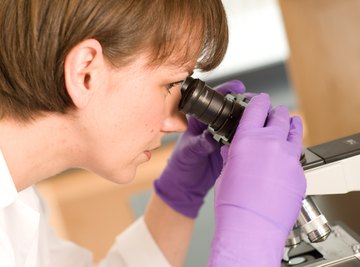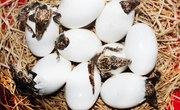
While Robert Hooke's cork cell observations (1665) triggered the study of microscopic structures, Antoni van Leeuwenhoek's 1676 observations earned him the title of "Father of Microbiology." The tiny creatures Leeuwenhoek called 'animalcules' aroused much curiosity.
Over time, studies of animalcules destroyed belief in spontaneous generation, solved the mystery of spoiled wine and saved millions (if not billions) of lives threatened by disease, pollution and bad food.
Microbiology Definition
A formal microbiology definition states that microbiology studies "microorganisms, or microbes, a diverse group of generally minute, simple life-forms that include:
- bacteria
- archaea
- algae
- fungi
- protozoa
- viruses." Microbiologists also study the structure, function and classification of these microorganisms and how to use and control them
Microbiology in Everyday Life
Sometimes studying microscopic organisms may seem unimportant. However, microorganisms impact many aspects of everyday life. Understanding these impacts may help understand why microbiology importance cannot be underestimated.
Food and Food Safety
The natural processes of microorganisms impact food in both positive and negative ways. The existence of the Food and Drug Administration (FDA) emphasizes the importance of microbiology in everyday life.
Among his many discoveries, Louis Pasteur discovered that fermentation of wine and beer depend on microbial processes. Fermentation also develops the flavors of cocoa beans, tea leaves and coffee grains. In Africa products from fermented manioc provide dietary staples. Fermented soy and fish items are consumed daily in many Asian countries. Pickles, sauerkraut, yogurt and kimchi all require microbial activity.
Bread rises because of the carbon dioxide released by yeast as the yeast grows. The transformation of milk to cheese requires microbes. Cheeses like blue cheese develop with the introduction of nontoxic mold.
Food-borne illnesses
Some microorganisms, however, thrive in food while making that food unsafe for human consumption. In 2011, food-borne illnesses impacted an estimated 48 million people in the U.S. The estimated annual cost of food-borne illnesses, $7 billion, comes from medical treatment and lost work time.
Food-borne illnesses can be caused by bacteria, viruses, parasites, natural toxins (often a byproduct of microorganism activity) and environmental toxins. Food spoilage occurs when microorganisms decompose food.
Pasteur demonstrated that heating food and beverages before sealing them into a container killed the microorganisms that caused foods to spoil. Safe food preservation methods let food be stored and shared over time and distance.
Environment and Ecosystems
Microorganisms fill many niches in environments.
Microbes like the chemosynthetic bacteria at deep sea vents and phytoplankton (floating photosynthesizing microorganisms) form the base of many aquatic food chains. Fungi, bacteria and protists perform the important task of decomposition that releases nutrients back into the environment.
A gram of soil contains an estimated one billion microorganisms from possibly thousands of species. Microbiological studies of bacteria, viruses, protists and fungi in soil ecosystems led to understanding the carbon, nitrogen, phosphorus and sulfur cycles. Since these nutrient cycles in soil allow the continued existence of life on Earth, learning about these microorganisms seems worthwhile.
Studies of microorganisms in extreme environments suggests the possibility of life on other planets, in environments completely inhospitable to human life.
Microorganisms on Earth live in environments ranging from underground oil reservoirs to salt lakes and other extreme saline environments, from boiling hot springs to ice cold habitats and in environments with pH ranges from very acidic to very alkaline. These extreme environments show that microorganisms could survive elsewhere in the universe.
Health and Medicine
Robert Hooke's observations of cell walls in cork mark the beginning of microbiology, the study of small life forms. Others continued those studies.
Studies in the 1700s eventually led to Louis Pasteur's final blow to spontaneous generation, the then-prevalent belief that living things could arise from nonliving materials. These studies showed that microbes had to have traveled from place to place.
Understanding vectors, those methods of transport, led to many health practices, including washing one's hands before eating and after using the bathroom.
Germ Theory
Germ theory, the idea that microorganisms could cause diseases, seemed ridiculous to many, at first. The practice of washing hands and equipment just to get them dirty again met resistance among many, including butchers and surgeons.
But changes in medical procedures by then-radical thinkers like Joseph Lister led to improved surgical outcomes. The reduction of infection-related deaths convinced many to accept the possibility that microorganisms could, in fact, kill humans.
Studies of mold in a Petri dish of bacteria led to Fleming's discovery of penicillin. Similar studies in soil ecosystems led to discoveries of additional antibiotics. For example, two antibiotics (chloramphenicol and streptomycin) came from studies of soil microbiology by Mildred Rebstock and others. The rise of antibiotic resistant and flesh-eating bacteria shows the continued need to learn microbiology.
Research and Teaching
Microbiology research provides answers (and questions) about microorganisms. Pasteur's research into spoilage of beer and wine led to health practices like pasteurization of beer, wine and, after 1886, milk. Pasteur's techniques led to the discovery of viruses by the Russian microbiologist Dmitry Ivanovsky. Vaccinations and treatments for diseases ranging from rabies to smallpox to HIV and AIDS came from microbiology research.
Researchers test microorganisms to understand their behaviors and interactions. Information about minute organisms may seem trivial, but microbiology research has led to improved crop yields, bioremediation of pollutants like oil and diesel and techniques to cure diseases, reduce food-borne illnesses and prevent infections.
References
- About Bioscience: Bioscience Careers: Microbiologist
- Microbiology Gateway: Environmental Microbiology
- Online Etymology Dictionary: Micro-
- Online Etymology Dictionary: Biology
- Encyclopaedia Britannica: Microbiology
- Microbiology Society: What is Microbiology?
- Weber State University: History of Microbiology Lecture Notes
- Encyclopaedia Britannica: Dmitry Ivanovsky
- American Society of Microbiologists: ASM Archives
- eatCultured: Fermentation - The Basics
- University of Utah Learn.Genetics: Microbes at Work
- University of Utah Learn.Genetics: The Microbiome and Disease
- European Food & Feed Cultures Association: Microorganisms in Food Production
- University of California Cooperative Extension: Cottage Food Operator's Handbook - Food Safety
About the Author
Karen earned her Bachelor of Science in geology. She worked as a geologist for ten years before returning to school to earn her multiple subject teaching credential. Karen taught middle school science for over two decades, earning her Master of Arts in Science Education (emphasis in 5-12 geosciences) along the way. Karen now designs and teaches science and STEAM classes.
Photo Credits
Jupiterimages/Photos.com/Getty Images
